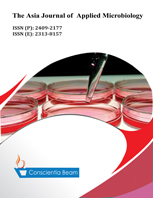Antibacterial and Antioxidant Activity of Bacillus Species Isolated from Fermented Parkia biglobosa (IRU) and Ricinus communis (OGIRI)- African Traditionally Fermented Food Condiments
DOI:
https://doi.org/10.18488/journal.33.2020.71.19.29Abstract
Fermented food condiments are essential parts of the diet of various cultures in different part of the world. Iru and ogiri are locally produced food condiments in Nigeria made from locust beans (Parkia biglobosa) and castor oil seeds (Ricinus communis) respectively. An attempt was therefore made in this study to isolate and characterize different Bacillus species from the condiments samples as well as investigate the antibacterial and antioxidant properties of some selected Bacillus species. Five Bacillus species were isolated from the condiment samples using standard methods, in-vitro antibacterial activity of Bacillus species was carried out using the agar well diffusion method. The broth dilution technique was used to determine the minimum inhibitory concentration and minimum bactericidal concentration of Bacillus species while thin layer chromatography technique was employed to identify a metabolite produced by B. subtilis. The predominant Bacillus species isolated from ogiri were: B. mycoides and B. subtilis; iru pete: B. mycoides, B. licheniformis while B. brevis and B. licheniformis were the predominant Bacillus species isolated from iru woro. The results of the antibacterial activity of the selected Bacillus species revealed that the following organisms OGA3, IWA3, IWB5, IPI3, OGB3, IPB3 and IPH3 showed the following zones of inhibition against: Escherichia coli (0mm, 16mm, 0mm, 13mm, 0mm, 14mm and 0mm); Corynebacterium diphtheriae (0mm, 0mm, 0mm, 20mm, 17mm, 0mm and 0mm); Proteus mirabilis (0mm, 17mm, 16mm, 20mm, 23mm, 18mm, and 19mm) while Staphylococcus aureus and Klebsiella pneumoniae showed the same zones of inhibition (0mm, 0mm, 0mm, 0mm, 0mm, 0mm, and 0mm). IWA3 and IPI3 exhibited MIC of 3.7mg/ml against E. coli; IPI3 showed MIC of 2.5mg/ml against C. diphtheriae, IWA3 and IWB5 exhibited MIC of 2.5mg/ml against P. mirabilis. No MIC was recorded for S. aureus and K. pneumoniae. Nevertheless, only IWA3 showed minimum bactericidal concentration (MBC) of 3.5mg/ml and 3.7mg/ml against E.coli and P.mirabilis respectively. OGB3 and IPB5 exhibited 65.80% and 27.52% antioxidant activity while the reducing power was recorded as 0.683 and 0.309 . In addition, OGB3 produced a metabolite known as iturin which is a strong anti-fungal agent. Therefore, it can be concluded that the Bacillus species isolated from condiment samples can be used as an antimicrobial agent against P. mirabilis as they showed higher zones of inhibition than the control antibiotic (gentamycin). In addition, OGB3 (B. subtilis isolated from ogiri) can also serve as a potential biopreservative in foods.

